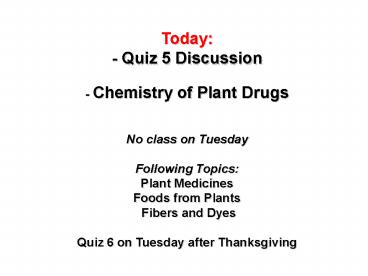PIGMENTS, PERFUMES AND POISONS - PowerPoint PPT Presentation
1 / 27
Title:
PIGMENTS, PERFUMES AND POISONS
Description:
It has a large number of conjugated double bonds! ... Often bitter taste. Papaver somniferum. Isolation: beginning 19th century. Structure: 1889 ... – PowerPoint PPT presentation
Number of Views:78
Avg rating:3.0/5.0
Title: PIGMENTS, PERFUMES AND POISONS
1
Today - Quiz 5 Discussion- Chemistry of
Plant DrugsNo class on TuesdayFollowing
TopicsPlant MedicinesFoods from Plants Fibers
and DyesQuiz 6 on Tuesday after Thanksgiving
2
Quiz 5 Answers High 20 Low 5 Average
16.0
- Which of the following molecules would you assume
to have a color - (to humans)? Explain also Why/ why not?
- a)
- b) This one! It has a large number of conjugated
double bonds!
3
- Which of the following molecules would you assume
to have a color (to humans)? Explain also why/why
not. - a)
- This one! It has a large number of conjugated
double bonds! - b)
4
True or false _____T_______ Light is a form of
energy. ______F______ The color of a pigment is
the color that is
absorbed. _____
T _______ The colors of rocks include minerals
that contain transition metals. ______ F ______
All higher animals have the same range of color
vision as humans.
_____ T _______ The range of light visible to
humans is about 400 750 nm ______ F ______All
higher animals have the same range of color
vision as humans. _____ T _______Bees can see
UV. ______ T ______ The color of a pigment is not
the color that is absorbed.
5
- List all that apply underneath each respective
molecule - Which of the two pigment molecules below
- 1. have an aromatic ring in their structure
(circle) ? - 2. have conjugated double bonds?
- 3. are water-soluble?
1., 2., 3.
1., 2., 3.
1., 2., 3.
2. (only!)
6
- What makes it a phenolic compound?
- The structure of the benzene ring with a
- OH group attached
- b) Why is it poorly soluble in water? The long
hydrocarbon rest together with the benzene ring
(versus just two OH groups) make urushiol poorly
soluble in water.
Urushiol is the irritant in poison oak (see
structure below).
- What makes juglone a phenolic compound?
- The structure of the benzene ring with a OH group
attached - b) What makes juglone slightly water-soluble?
- The OH group and two O atoms and not too many
carbons
Juglone (see structure below) is a compound in
walnut trees that keeps other plants from growing
7
A Word on Cheating during Quizzes
8
- Final Paper (60 Points)
- Your suggestion of topic, with a brief written
summary, - is due by
- Thursday, November 13 (this Thursday!)
- Your Final Paper is due Thursday, Dec. 11, class
time (our last class) - Early papers welcome!
- Early Bird Bonus of 5 pts. if handed in by
Dec.4. - Your Final Paper must be a printed copy.
- Electronic submissions are NOT accepted.
- Late papers are NOT accepted.
9
- Your Final Paper must be on a plant chemistry
topic. - It needs to relate to our class.
- Do include some relevant chemical structures.
- Your paper must include
- Your name, date, title
- Introduction Give background to topic address
reason why you chose this topic. Include relevant
chemical structures. - Main body which should include your own thoughts,
connection with C107. - A brief conclusion
- Sources (book, websites etc.) with at least two
copies of title page(s) - Your paper must be written independently.
- Sources must be clearly cited.
10
Humans and PlantsPlant Drugs
- How do Plant Drugs relate
- to our earlier class material?
- Chemical Defenses in Plants
- Plant Toxins
- Cyanogenic glycosides
- Alkaloids
- Saponins
- Cardenolides
- Some plant families
11
Molecules and Descriptions
For Molecule Structures http//www.3dchem.com/at
oz.asp
For molecule structures, history and
activity http//www.chm.bris.ac.uk/motm/motm.htm
12
Alkaloids
N-containing complex organic compounds from
plants Alkaline. Often bitter taste.
Papaver somniferum
- Isolation beginning 19th century
- Structure 1889
- Synthesis 1952
13
Opium Composition
14
Prickly Poppy
Papaverin, an opiate alkaloid in poppy species.
15
Alkaloids
Ergot (Claviceps purpurea) on Rye
St. Anthonys Fire
Lysergic Acid
16
Alkaloids
Albert Hoffmann 1943
http//www.chm.bris.ac.uk/motm/motm.htm
17
Alkaloids
Serotonin a neurotransmitter
LSD
18
Alkaloids
In Psilocybe spp. (magic mushrooms)
19
http//www.bris.ac.uk/Depts/Chemistry/MOTM/motm.ht
m
20
Alkaloids
Peyote cactus (Lophophora williamsii)
21
Alkaloids
22
Alkaloids
Ephedra
Ephedrine
23
Alkaloids
Scopolamine an alkaloid
Datura wrightii
24
Tetrahydrocannabinol THC
Active component in Cannabis
25
(No Transcript)
26
(No class Tuesday)Next timePlant Medicines
27
Practice
- Re. the molecules below .
- which one(s) is/are aromatic?
- which one has/have a phenol ring?
- has/have chiral centers?
- which one is/are an alkaloid?
- Which is best soluble in water?
A
C
B

